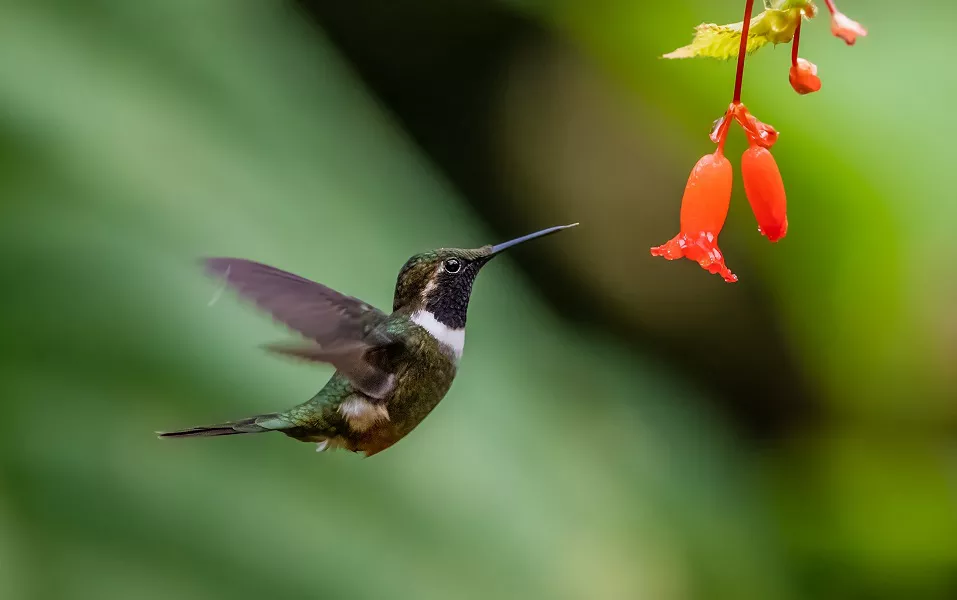Hummingbirds, with their vibrant plumage, rapid wingbeats, and remarkable hovering ability, are among the most captivating and enchanting birds in the avian world. These tiny, energetic birds have specific dietary needs that set them apart from other bird species. In this article, we will explore the fascinating dietary habits of hummingbirds, shedding light on their specialized feeding techniques, preferred food sources, and the essential role that nectar plays in their survival.
Nectar: The Main Source of Food
The primary food source for hummingbirds is nectar. Nectar is a sugary liquid that is found in flowers. Hummingbirds have long, thin beaks that are perfectly designed to reach deep into the flowers to extract the nectar. As they feed, they inadvertently pick up pollen on their beaks and their feathers, which they then transfer to other flowers, helping to pollinate them.
To keep up with their high energy needs, hummingbirds need to consume a lot of nectar. They will typically visit hundreds of flowers each day, drinking up to twice their body weight in nectar. This means that they need to feed almost constantly throughout the day, visiting dozens of flowers every hour.
Floral Preferences and Coevolution
Hummingbirds exhibit specific preferences for certain types of flowers, often favoring tubular or trumpet-shaped blossoms. These flowers typically contain high concentrations of nectar, making them an abundant and energy-rich food source for these avian acrobats. The shape and structure of the flowers have evolved to match the hummingbirds’ specialized bills, forming a mutualistic relationship known as coevolution. While the hummingbirds obtain nourishment from the nectar, they inadvertently assist in the pollination of these flowers by transferring pollen from one blossom to another.
Insects: A Source of Protein
While nectar is the main source of food for hummingbirds, it does not provide all the nutrients that they need. To supplement their diet, hummingbirds also consume insects. Insects are an excellent source of protein, which is essential for building strong muscles and maintaining good health.
Hummingbirds are skilled hunters, and they prey on a variety of insects, including flies, mosquitoes, gnats, and spiders. They catch their prey by hovering in the air and snatching insects out of the air as they fly by. They can also pluck insects from leaves and branches while perched on a nearby plant.
Sap, Pollen, and Tree Exudates
In addition to nectar and insects, certain hummingbird species have been observed consuming tree sap, pollen, and other sticky plant exudates. This behavior is commonly observed when nectar sources are scarce or during the non-breeding season when insects are less abundant. While these alternative food sources may not be as prevalent in the hummingbird’s diet as nectar and insects, they provide an additional energy and nutrient boost.
Feeding Habits
Hummingbirds have unique feeding habits that are different from other birds. Because they need to consume so much nectar each day, they have developed a specialized digestive system that allows them to process large amounts of sugar quickly. Their long beaks and tongues are perfectly adapted for reaching deep into flowers to extract the nectar.
To conserve energy while feeding, hummingbirds have also developed the ability to hover in mid-air. This allows them to remain stationary while feeding, rather than expending energy flying from flower to flower. They also have a high metabolism, which allows them to convert food to energy quickly.
Metabolism
Hummingbirds have a high metabolism and require a lot of energy to fuel their rapid wingbeats and hovering flight. In fact, they have the highest metabolism of any bird species, with some species able to consume up to twice their body weight in nectar and insects per day. To maintain their energy levels, hummingbirds must feed almost constantly and can consume up to 10 times their body weight in nectar each day.
Conservation Considerations
Preserving the habitats and food sources of hummingbirds is essential for their survival. Planting nectar-rich flowers, avoiding pesticide use, and maintaining clean and accessible water sources can help attract and support these delightful birds. It is also crucial to raise awareness about the importance of protecting their breeding grounds during migration and promoting the conservation of their natural habitats.
Conclusion
Hummingbirds have evolved remarkable adaptations to thrive on a specialized diet of nectar, supplemented by insects and other food sources. Their unique feeding techniques, floral preferences, and role in pollination make them ecologically significant. By understanding and appreciating the dietary habits of hummingbirds, we can contribute to their conservation and create welcoming environments that sustain these iridescent wonders of the avian world.
Related topics:
- How to Make Hummingbird Feed: A Step-by-Step Guide
- How to Make Hummingbird Juice: A Step-by-Step Guide
- A Guide to Making Hummingbird Nectar at Home
- How To Attract Hummingbirds, 5 Effective Methods


 Facebook
Facebook  Instagram
Instagram  Youtube
Youtube 